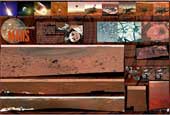
 |
|
|
Subtitled, ‘How Celestial Observations Have Shaped Civilization’, this book is an enthralling account that takes the reader through a vast array of cultures and their beliefs. The subject matter is very en-vogue at the moment with a plethora of books attempting to decipher new ancient and cultural evidence that seems to be emerging on a daily basis. As each succeeding generation adds a new interpretation, so the world appears to be getting closer to the truth of the ancients. The author takes us on a broad path that investigates the various global cultures, monuments, rituals and ceremonies that allow for linkages to our normal starting points as astronomers. These points being, why do we have seasonal cycles? What is the significance of time? What causes the Sun, Moon and planets to move across our sky? How do these phenomena influence our lives spiritually, intellectually and emotionally? The contrasts outlined by the author are clear and concise throughout, no more so than in the section that deals with calendars and time. Take the case of ancient Hawaiians who chose to “...develop an original lunar calendar that made use of the lunar months and the position of the Pleiades star cluster to create a stellar–lunar calendar” and compare that the Zuni Native American tribe who used ceremonies as the basis of their calendar. Other Native Americans were known to relate animal behaviour, contrasting with the ancient Greeks who are thought to have used a combination of natural cycles related to changing patterns in the skies. This book allows us to appreciate a plain of spiritual reasoning rather than, as so often the case, taking the science and dismissing the spiritual base. After all, we still have lifestyles dictated by the seasonal calendars, ceremonies and celebrations so why ignore this when discussing scientific levels? I am impressed author’s presentation of evidence. The pace and order is consistent throughout. The use of illustrations, many of which are the author’s own photographs, support and underpins the text fully. I recommend this book to all who wish to blend the astronomy with cultural principles to strengthen the celestial debate. This book stands out as a study of human culture and astronomical relevance. Ian Welland
|
|
|
|
2009 Yearbook This 132-page special edition features the ultimate observing guide for 2009, a review of all the biggest news stories of 2008, in depth articles covering all aspects of astronomy and space missions for 2009, previews of International Year of Astronomy events and much, much more. This 132-page special edition features the ultimate observing guide for 2009, a review of all the biggest news stories of 2008, in depth articles covering all aspects of astronomy and space missions for 2009, previews of International Year of Astronomy events and much, much more.Infinity Rising  This special publication features the photography of British astro-imager Nik Szymanek and covers a range of photographic methods from basic to advanced. Beautiful pictures of the night sky can be obtained with a simple camera and tripod before tackling more difficult projects, such as guided astrophotography through the telescope and CCD imaging. This special publication features the photography of British astro-imager Nik Szymanek and covers a range of photographic methods from basic to advanced. Beautiful pictures of the night sky can be obtained with a simple camera and tripod before tackling more difficult projects, such as guided astrophotography through the telescope and CCD imaging.Exploring Mars  Astronomy Now is pleased to announce the publication of Exploring Mars. The very best images of Mars taken by orbiting spacecraft and NASA's Spirit and Opportunity rovers fill up the 98 glossy pages of this special edition! Astronomy Now is pleased to announce the publication of Exploring Mars. The very best images of Mars taken by orbiting spacecraft and NASA's Spirit and Opportunity rovers fill up the 98 glossy pages of this special edition!Mars rover poster  This new poster features some of the best pictures from NASA's amazing Mars Exploration Rovers Spirit and Opportunity. This new poster features some of the best pictures from NASA's amazing Mars Exploration Rovers Spirit and Opportunity. |
||||||||||||||||||||||||